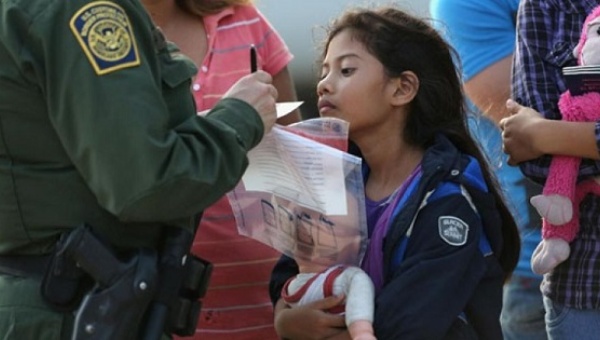US: Cubans Welcome, but Vulnerable Latin Americans Stay Out!
Adriana Maestas, Telesur | Tuesday, 24 May 2016 | Click here for original article

Salvadoran immigrant watches as a US Border Patrol agent records family information
No other group of migrants from Latin America receives the same special treatment from the U.S. government as the Cubans do.
While President Obama is in Cuba this week (article written in March 2016) to rebuild bilateral relations and encourage business opportunities on the island, there’s an immigration crisis brewing along the southern border highlighting how Cuban immigrants are privileged over Mexican and Central American migrants.
In the last fiscal year, 43,124 Cubans entered the country according to the U.S. Customs and Border Protection. From Oct. 1, 2015 through Feb. 24, 2016, an additional 25,805 Cubans have entered. In the past 17 months, 68,930 Cubans have come to the U.S. where they are processed and become eligible for food stamps, Medicaid, and eventually a work permit and legal residence.
Most of the Cuban migrants are coming through the border crossing in Laredo, Texas, where they have come up through Central America. Laredo is now the favored entry point because Cubans can avoid the danger and drama of being caught by the Coast Guard off of the sea in Florida while in a rickety boat. The U.S. government’s “wet-foot, dry-foot” policy allows Cubans who arrive on U.S. soil to be paroled in, while those who are captured on the water are sent back to the island.
No other group of migrants from Latin America receives the same special treatment from the U.S. government as the Cubans do. The generous immigration policy is a product of the Cold War when the U.S. sought to "Americanise" Cubans. The U.S. wanted offer them refuge from political persecution. Over the years, the policy has been revised in response to waves of Cuban migration with “wet-foot, dry-foot” being the latest.
While Cuban migrants are welcomed and processed at the border within an hour or so, refugees from Central America and Mexico are caught, detained, and most likely deported. Yet some in the U.S. continue to justify the preferential immigration policy for Cubans by citing the human rights record of the Cuban government.
According to the Amnesty International 2015/16, The State of the World’s Human Rights Report, in Mexico more than 27,000 people remained missing or disappeared and that human rights defenders and journalists “continued to be threatened, harasses, or killed.” There are also extrajudicial executions and torture in Mexico.
Last year according to a report in The Guardian, the countries in Latin America with the highest death rates in relation to the number of inhabitants were Honduras and El Salvador. Some of the most dangerous cities in Latin America are in Honduras and in Mexico, but Cuba reports having one of the lowest homicide rates in the Americas. According to the United Nations Office on Drugs and Crime, in 2012 Cuba had a homicide rate of 4.2 per 100,000 people, which was the third lowest rate in the hemisphere after Canada and Chile. The U.S. had a higher homicide rate than Cuba with 4.7 homicides per 100,000 people.
For the past three years, the U.S. has been addressing the crisis of unaccompanied minors at the southern border. Earlier this year, the Obama administration launched raids that targeted women and children from Central America. In January, it was reported that the Department of Homeland Security (DHS) had apprehended 121 Central Americans with outstanding deportation orders. DHS also told immigrant rights advocates that it was going to expand raids to include minors who entered the U.S. on their own to deter other children from making the perilous journey north. A report from March 2015 showed that over 7,000 migrant children had been ordered deported without appearing in court since 2013. Between October 2013 and January 2015, the U.S. government filed deportation cases against 62,363 minors.
The U.S. is detaining and then deporting Central American children back to dangerous countries, while extending the welcome mat to Cubans who touch U.S. soil. Mexican children aren’t even extended the opportunity to make their case for asylum that most Central American children have, though it could be argued that the immigration proceedings are more like a kangaroo court. Recently, a U.S. immigration judge claimed that he has taught immigration law to three- and four-year-old children who appeared before him. Instead of appearing before a judge, Mexican children receive “expedited repatriation” and are screened by the Border Patrol, limiting their chances to receive any relief.
While President Obama may try to address human rights during his historic trip to Cuba, he should not be so quick to point fingers when his administration has continued to implement immigration policies that prefer Cubans over other migrants from the region. The U.S. should either extend the generous “wet-foot, dry-foot” policy to others who are seeking refuge or end it altogether. The Cuban immigration exception has not produced regime change in Cuba, which is what Washington had always wanted, but it has shown how hypocritical the U.S. is in treating migrants from a relatively safe country compared to those who are fleeing some of the most dangerous countries.






